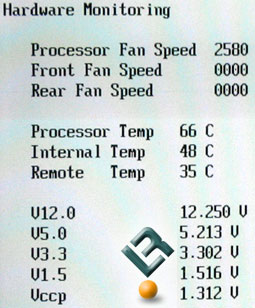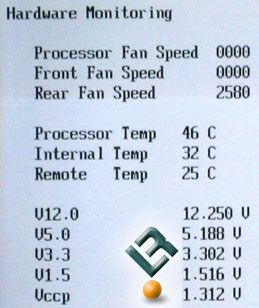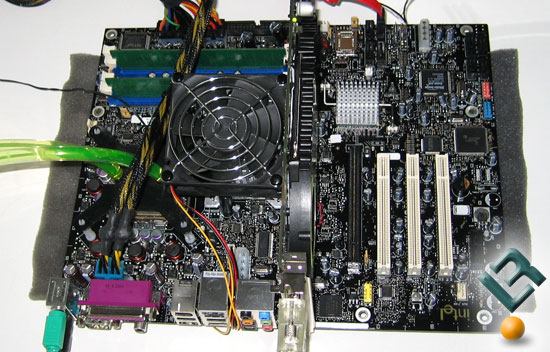Intel Dual Core: Pentium EE 840 Arrives
The Intel 840 Up Close
The Intel Pentium Extreme Edition 840:
The Intel 840 processor does not have many features that we have not seen before on a single core processor. As you can tell from the chart below it is basically two prescott cores with 1MB cache that have been attached.
|
Pentium 4 5XX |
Pentium 4 6XX |
Pentium 4 EE 3.73 GHz |
Pentium EE 840 |
|
|
Package |
LGA775 |
LGA775 |
LGA775 |
LGA775 |
|
Processor rating |
570, 560, 550, 540, 530, 520 |
660, 650, 640, 630 |
None |
840 |
|
Clock frequencies |
2.8 ? 3.8 GHz |
3.0 ? 3.6 GHz |
3.73 GHz |
3.20 GHz |
|
Bus frequency |
800 MHz |
800 MHz |
1066 MHz |
800 MHz |
|
Core |
Prescott |
Prescott 2M |
Prescott 2M |
Dual Core |
|
Manufacturing technology |
90nm, strained silicon |
90nm, strained silicon |
90nm, strained silicon |
90nm, strained silicon |
|
L1 data cache |
16 KB |
16 KB |
16 KB |
2 x 16 KB |
|
Trace cache |
12000 micro-ops |
12000 micro-ops |
12000 micro-ops |
2 x 12000 micro-ops |
|
L2 cache |
1024 KB |
2048 KB |
2048 KB |
2 x 1024 KB |
|
EM64T |
None |
Yes |
Yes |
Yes |
|
XD-bit |
Yes |
Yes |
Yes |
Yes |
|
EIST |
None |
Yes |
None |
Yes |
|
Hyper-Threading |
Yes |
Yes |
Yes |
Yes |
|
SIMD-instructions support |
SSE, SSE2, SSE3 |
SSE, SSE2, SSE3 |
SSE, SSE2, SSE3 |
SSE, SSE2, SSE3 |
|
Number of transistors |
125 mln |
169 mln |
169 mln |
230 mln |
|
Die size |
112 sq.mm |
135 sq.mm |
135 sq.mm |
206 sq.mm |
While some execution resources (such as caches, ececution units, and buses) are shared, each logical processor on the 840 has its own architecture set. Each individual architecture set contains its own set of general-purpos registers and control registers to provide increased system responsiveness in multitasking and increased headroom for future multithreaded applications. The Intel 840 offers full four thread functionality, which for threaded applications should lead to very noticable performance gains. Not too many threaded benchmarks are available, but one where we should see the difference visually and in the results is Cinebench 2003 that we will run later.
Thermal Properties:
Enthusiasts might be a bit worried about the thermal properties on the Pentium Processor Extreme Edition 840 and so was Legit Reviews. We installed the latest Intel beta desktop software and noted that the temperature sensors were not yet working. After some testing where the system was under heavy loads we noted some restarts with the factory cooling solution (same HSF as any LGA775) and contacted our friends at Intel to help us monitor the temperatures. At the current time the only thing that can be used to monitor the temperatures on the test platforms is the Hardware Monitoring Utility that is found in the BIOS. We installed the HSF with a thin layer of Shin-EtsuMiccrosi thermal compound and installed the reference HSF. Our test bed was then installed in a mid-sized ATX case with three 80mm case fans and booted. Below is what we saw.
|
|
|
When the system posted temps were around 40C by the time the BIOS came up. They then climbed all the way up to 66C before leveling off, while the room temperature was at a mild 22C. Remember that this is at idle in the BIOS at default voltages and only 800MHz FSB. Default CPU voltage can be seen above at 1.312V, which isn’t bad at all considering the dual core design. We disabled and enabled the CPU fan control in the BIOS and it had no impact on idle performance in the BIOS.
We heard rumors around the community that Intel was trying out watercooling solutions for the dual core processors and could even possibly offer the Extreme Edition with H2O cooling as an option. Intel commented that they always experiment with the latest in cooling technologies; water cooling included, but has no plans of using it commercially. With that said, Intel said if we have watercooling go ahead and use it if we want. Well, we were going to anyway (our entire test bench is watercooled) and when we used the Corsair HydroCOOL 200ex paired with an 80mm case fan sitting on the northbridge we saw a 20C temperature decrease on the processor. That’s a difference of 36 Fahrenheit, for those trying to do quick math in their head.
Water cooling makes a HUGE difference on the thermal properties on these new Intel 840 processors. While some people might gripe about high temperatures, it shouldn’t be a big deal when we think about it. If a consumer is going to go out and buy a $1000 processor, $250 motherboard, $550 video card, and everything else to go along with it what is an extra $180-$250 for a quality water cooling solution? I bet companies like Corsair Memory, who started offering water cooling years ago, are jumping up and down with every new product launch. Enthusiasts wishing to overclock their high end processors are almost at the point they need to have water cooling to hit the numbers they are used to.
|
|
Now that we have taken a look at the general features of the new dual core Intel 840 processor, lets move onto the new chipset.




Comments are closed.